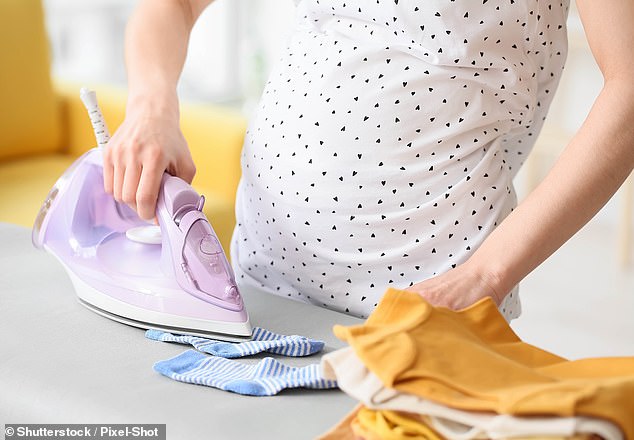[ad_1]
With so many different chores to keep up with, it can be easy to forget about washing all your odd socks.
But scientists say that falling behind on the laundry could lead to more than just smelly feet.
Dr Primrose Freestone, a microbiologist from the University of Leicester, warns that your feet are a ‘miniature rainforest of bacteria and fungi’.
Thankfully, Dr Freestone has revealed the proper method for keeping your socks clean and fresh for as long as possible.
Dr Freestone told the Daily Mail that you should use water which is ‘at least 60°C (140°F) with an enzyme-based detergent’.
Dr Freestone says: ‘The enzymes detach the bacteria from the weave of the sock fibres, and the high temperature kills the bacteria and fungi which are adapted to living at human foot temperature.
‘If your washing machine cannot manage a 60°C sock-microbe-killing temperature wash, then a hot iron will do the job – especially if the steam function is used.
‘This helps the iron heat to penetrate deep into the sock, which will kill any bacteria, verruca virus or athlete’s foot fungus.’

A microbiologist has revealed the proper way to wash your socks, and why it is important that you iron them (stock image)
Even though they stay safely inside our shoes for most of the day, our feet are among the dirtiest places on our bodies.
Studies have shown that feet can have anywhere from 10 to 100 million microbial cells living on every square centimetre of skin.
This is because our feet are warm, dark, and humid, a combination which helps bacteria thrive.
Your feet, especially between the toes, are packed with sweat glands, which keep conditions ideal for microbial growth.
To make matters worse, our socks pick up dirt and bacteria from everywhere we go.
Socks act as ‘microbial sponges’ for bacteria, fungi, and fungal spores from soil, water, pet hair, and general dust.
In one study, socks had the highest bacterial and fungal counts of any piece of clothing after being worn for just 12 hours.
Those microbes collected by your socks then make their homes in the comfortable environment of your feet, where they rapidly multiply.

Our warm, humid feet are the perfect environment to incubate the bacteria and fungi that our socks pick up. These microbes won’t be killed by a hot wash, so ironing is key to ensure your socks are really clean (stock image)
‘Feet can be a host for up to 1,000 different bacterial and fungal species, some of which can eat the sweat your feet produce, and their malodorous waste metabolites are what cause smelly feet, socks and shoes,’ says Dr Freestone.
Those bacteria range from relatively harmless residents to potentially dangerous pathogens such as Aspergillus, Staphylococcus, Candida, Histoplasma and Cryptococcus.
Staphylococcus bacteria are the cause of staph skin infections, which cause blisters and painful abscesses.
In serious cases, staph infections can even lead to infections such as blood poisoning and toxic shock syndrome.
Aspergillus, meanwhile, is a fungus which causes the respiratory condition Aspergillosis, leading to a wheezing cough that may bring up lumps of blood.
Once bacteria are growing your socks, they are unlikely to stay put.
Studies in hospitals have found that slipper socks worn by patients carried microbes from the floor into beds, including antibiotic-resistant pathogens.
However, the biggest infection risk from your socks is from more common skin infections.

Feet can be a host for up to 1,000 different bacterial and fungal species, such as Staphylococcus (illustrated), which causes Staph skin infections

In addition to causing painful lumps and swellings, Staph can lead to more serious conditions such as blood poisoning and toxic shock syndrome
Dr Freestone says: ‘You can pass on infections from dirty socks, such as verrucas, which are caused by the human papillomavirus and are highly contagious, so not washing socks and then walking on floors could infect others with your virus.
‘Athlete’s foot fungus also lives in socks and can spread via unwashed socks.’
In addition to changing your socks every day, Dr Freestone stresses that it is very important to wash socks properly to avoid being exposed to infections.
The problem is that regular laundry temperatures between 30-40°C (86-104°F) are well within the limits that microbes on your feet have evolved to survive.
‘Washing socks in detergent does help clean them, but I have done lab research which shows that some residual bacteria remain in socks if the wash is not a very hot one,’ says Dr Freestone.
Washing at higher temperatures or going over your socks with the iron will ensure that no unwanted pathogens survive the wash.
Dr Freestone adds: ‘My own socks got a hot wash with an antibacterial detergent and follow-on hot ironing, and so are sparkly clean- as are my feet!’
[ad_2]
This article was originally published by a www.dailymail.co.uk . Read the Original article here. .

